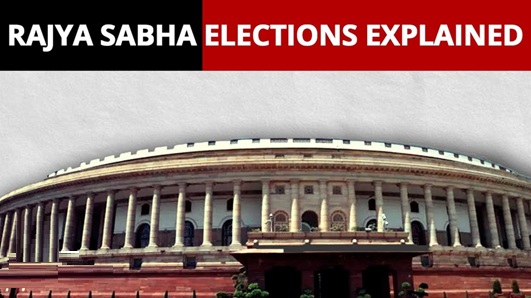(Preliminary Examination: Current Affairs)
(Mains Examination, General Studies Paper 2: Parliament and State Legislatures - Structure, Functions, Conduct of Business, Powers and Privileges, and Issues Arising Thereof.) |
Context
Recently, Rajya Sabha elections were held in Jammu and Kashmir, the first after the abrogation of Article 370. In these elections, the National Conference (NC) won three of the four seats, while the Bharatiya Janata Party (BJP) registered an unexpected victory in the fourth.

Rajya Sabha Election Process: An Analysis
The Rajya Sabha, known as the "Upper House," is the permanent house of the Indian Parliament. It has a total membership of 245, of which 233 are elected from the states and union territories, and 12 are nominated by the President.
Key Points
- Basis of Election: Members of the Rajya Sabha are not directly elected by the people, but are elected by the elected members of the state legislative assemblies.
- Voting Process: Each MLA ranks the candidates of their choice in order of preference (1, 2, 3, etc.).
- System: The election is conducted on the principle of proportional representation through the Single Transferable Vote system.
- Each MLA's vote has a single value (1), and the number of votes required to win (quota) is determined by the following formula:
- Quota = [Total Votes / (Number of Seats + 1)] + 1
- Example: In Jammu and Kashmir, with 87 MLAs, the quota for four seats = [87 / (4 + 1)] + 1 = 18.4, rounded to 19.
- If a candidate achieves this quota, they are declared victorious.
- If no candidate achieves the quota, the candidate with the lowest number of votes is eliminated, and their votes are transferred to other candidates based on second preference.
- Open voting: Rajya Sabha elections were conducted by secret ballot before 2003, but an amendment to the Representation of the People Act in 2003 introduced the open voting system.
- This system helps prevent cross-voting, but instances of cross-voting were reported in the recent Jammu and Kashmir elections.
- Vacancy situation: If a seat falls vacant, a by-election is held for the remainder of the term.
|
Did you know?
The single transferable vote (STV) system adopted for Rajya Sabha elections in India is inspired by Ireland. This system was first adopted in Ireland in 1922 and later incorporated into India's Constitution. The purpose of this system is to provide representation to different political parties and groups in proportion to their strength. This system, while complex, ensures fairness and inclusiveness
|
Jammu and Kashmir Rajya Sabha Elections
- A total of 87 MLAs of the Jammu and Kashmir Assembly voted.
- The BJP had 28 MLAs, but its winning candidate, Sat Sharma, received 32 votes.
- In addition to the BJP, Mohammad Ramzan, Sajjad Ahmed Kichloo, and Gurvinder Singh Oberoi of the NC Party also won.
- This result points to new equations and secret alliances in regional politics.
Role of the Election Commission
The Election Commission of India oversees the entire process of Rajya Sabha elections.
The main roles are as follows:
- Declaration of elections: The Commission announces the election dates and procedure.
- Nomination and verification: Candidates' nomination papers are scrutinized.
- Oversight of voting and counting: The Commission ensures that voting is conducted in a confidential and fair manner.
- Monitoring cross-voting and irregularities: If an MLA from a party votes against the party line, the Commission may investigate.
- Declaration of results: The Commission declares the final results and issues certificates to the winning candidates.
Conclusion
Rajya Sabha elections are a crucial part of India's democracy, bringing the voices of the states to the national Parliament. The recent elections in Jammu and Kashmir are proof that political balance and coalition politics play a decisive role in the composition of the Rajya Sabha. The impartiality and transparency of the Election Commission are key pillars of the credibility of this process.
|
Constitutional Provisions Related to the Rajya Sabha
- Article 80: Representation of States and Union Territories in Parliament
- This article defines the composition of the Rajya Sabha. It states:
- The Rajya Sabha can have a maximum of 250 (238 + 12) members.
- Each state and union territory is allocated seats based on their population and other factors, as mentioned in the Fourth Schedule of the Constitution.
- Members of the Rajya Sabha are indirectly elected, with elected legislators voting.
- Article 83: Term of the Houses of Parliament
- This article defines the permanent nature of the Rajya Sabha. The Rajya Sabha cannot be dissolved; one-third of its members retire every two years. Each member's term is six years.
- Article 84: Qualifications for Membership of Parliament
- This article sets out the qualifications for membership in both the Rajya Sabha and the Lok Sabha.
- Article 102: Disqualifications for Membership of Parliament
- This article states the circumstances under which a person may be disqualified from being a member of the Rajya Sabha or the Lok Sabha, such as holding an office of profit or committing an offence such as treason.
- Article 99: Oath or Affirmation
- Members of the Rajya Sabha must take their oath or affirmation.
- Article 100: Voting and Quorum
- This article lays down the rules for voting procedures and quorum (minimum attendance) in both Houses of Parliament. In the Rajya Sabha, the quorum is one-third of the total members.
- Article 249: If the Rajya Sabha passes a resolution by a two-thirds majority declaring a subject of national importance, Parliament is empowered to legislate on a subject in the State List.
- Article 250: The role of the Rajya Sabha during an emergency.
- Article 312: All India Services
- This article grants the Rajya Sabha the exclusive power to create All India Services if the Rajya Sabha passes such a resolution by a two-thirds majority.
- Important note: A two-thirds majority refers to the number of members present and voting, not a two-thirds majority of the total members.
|



